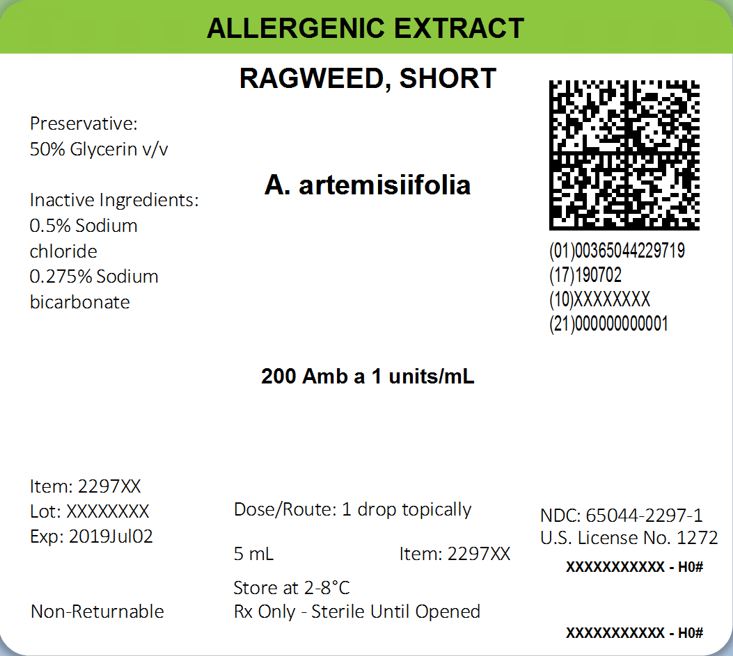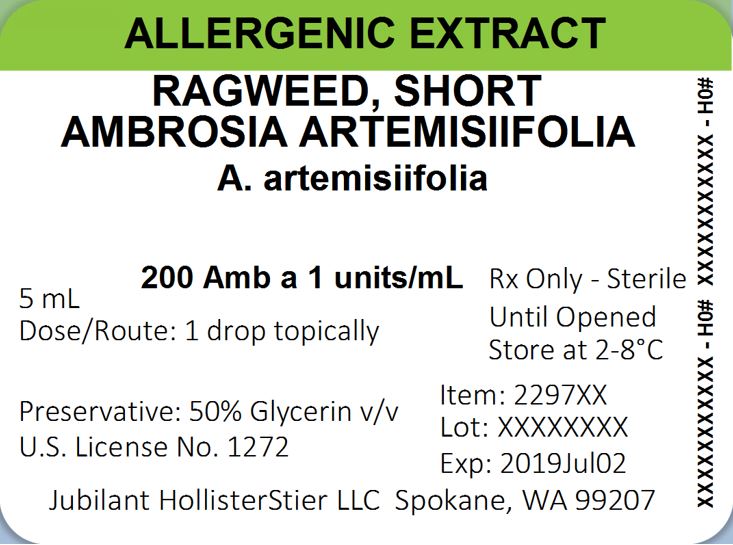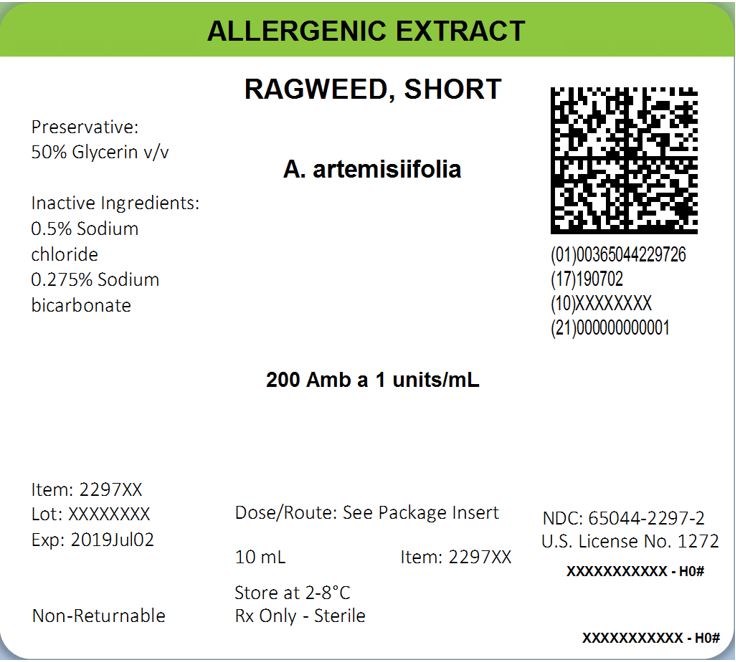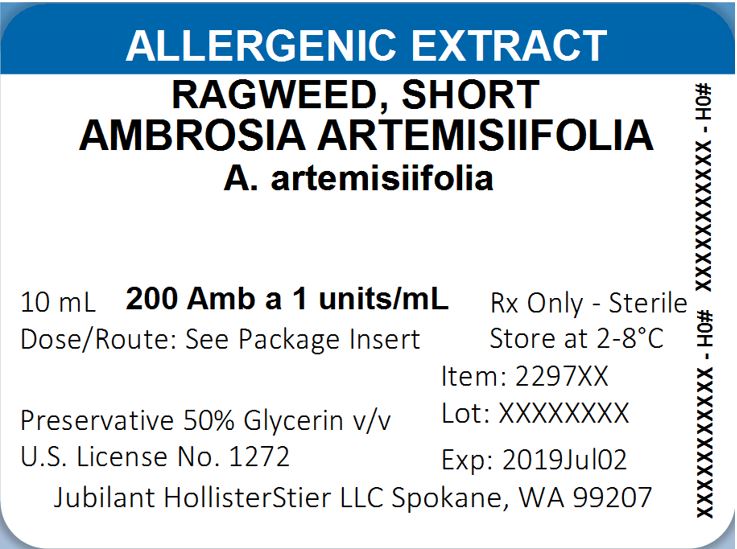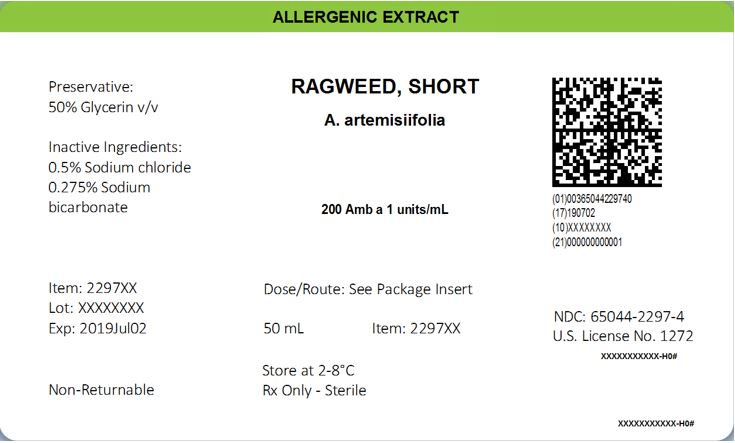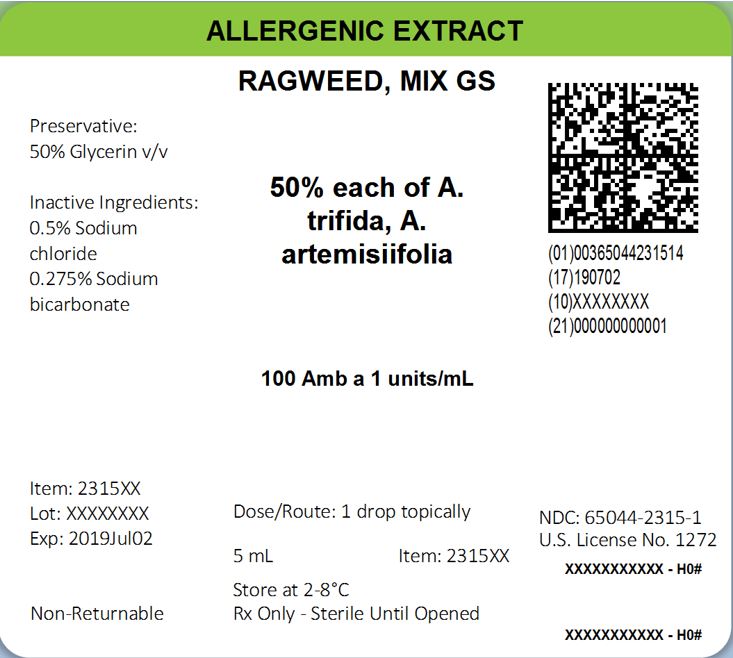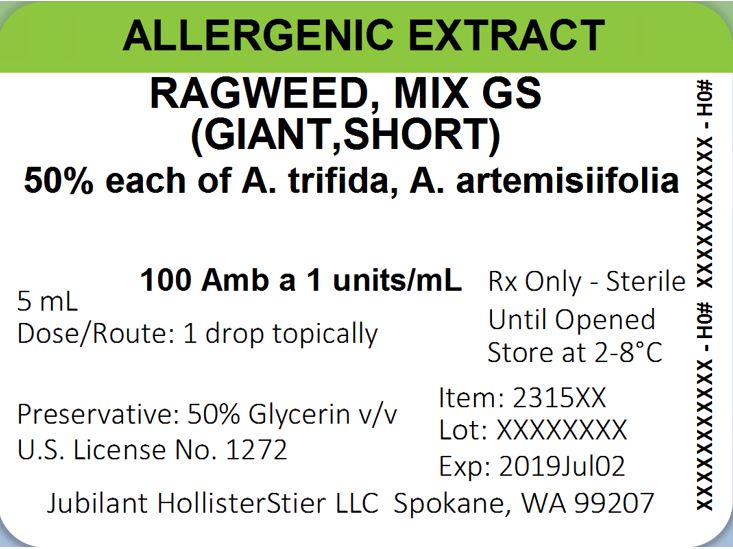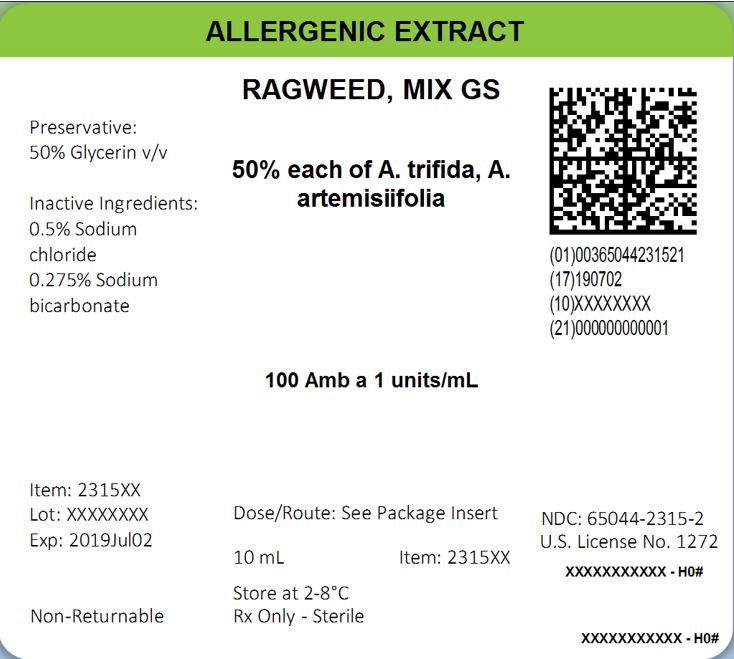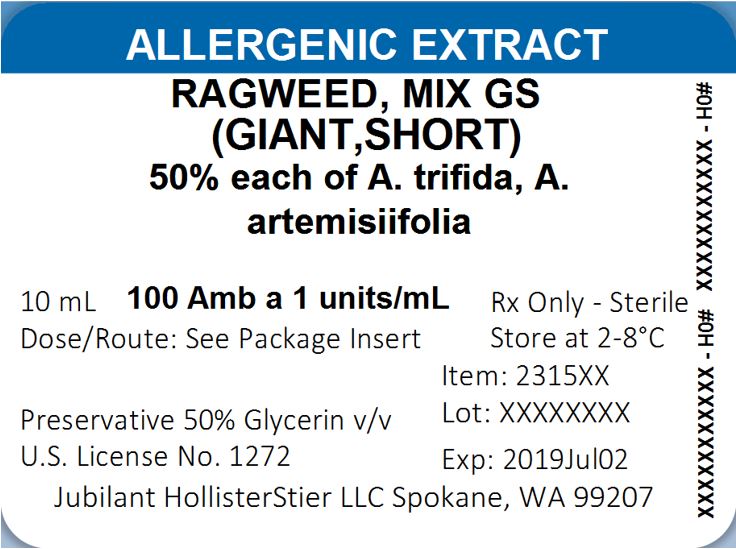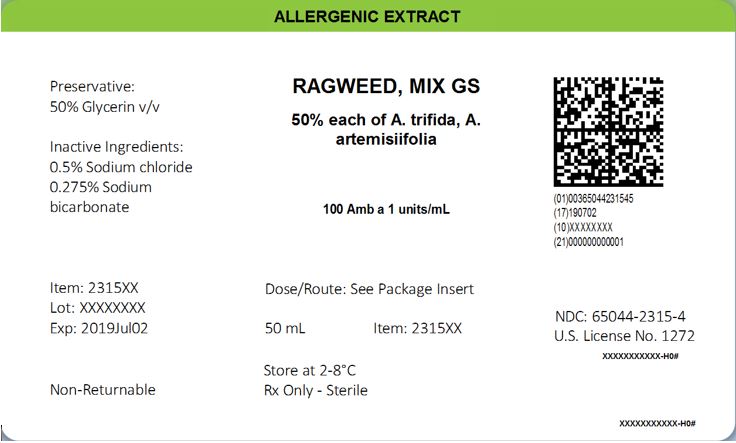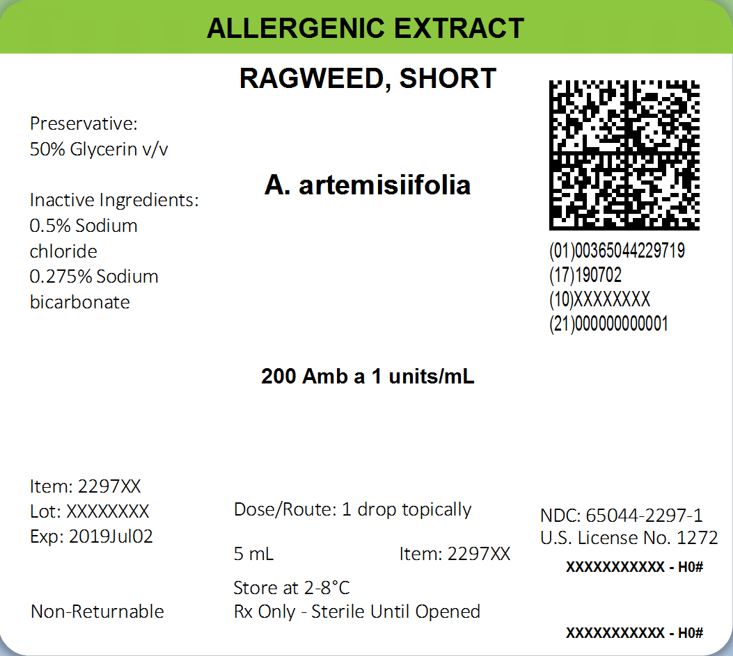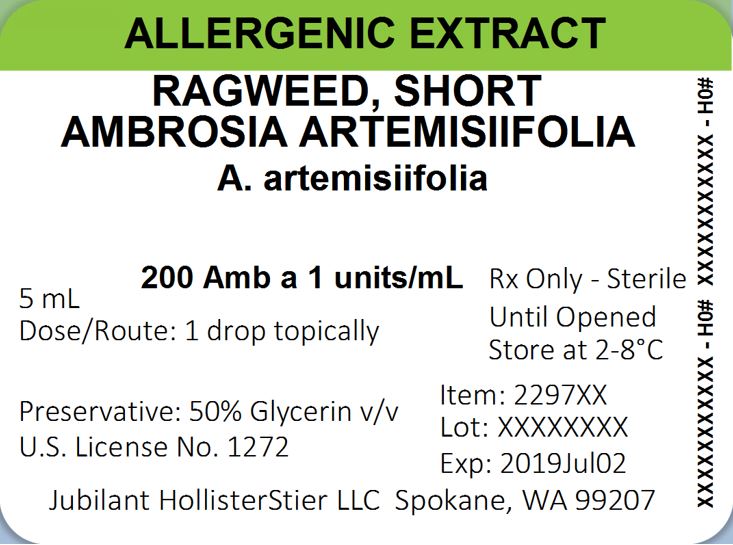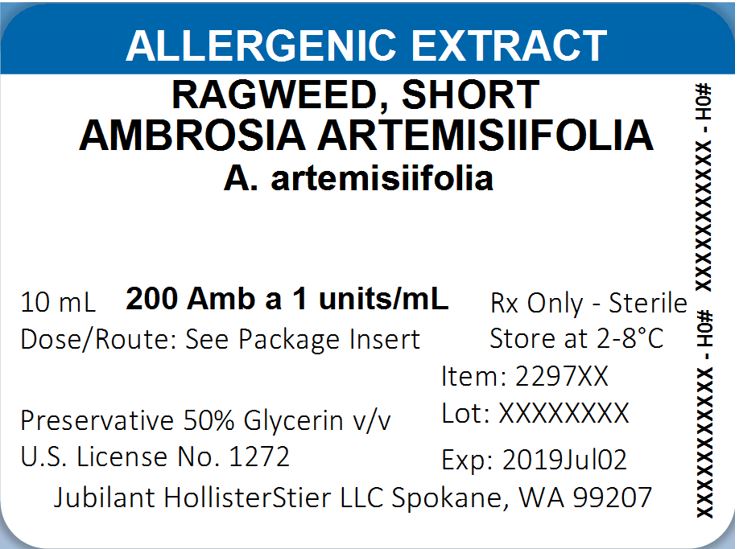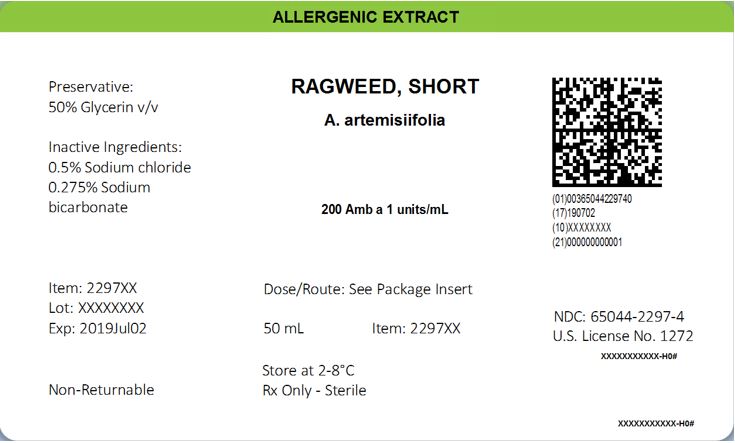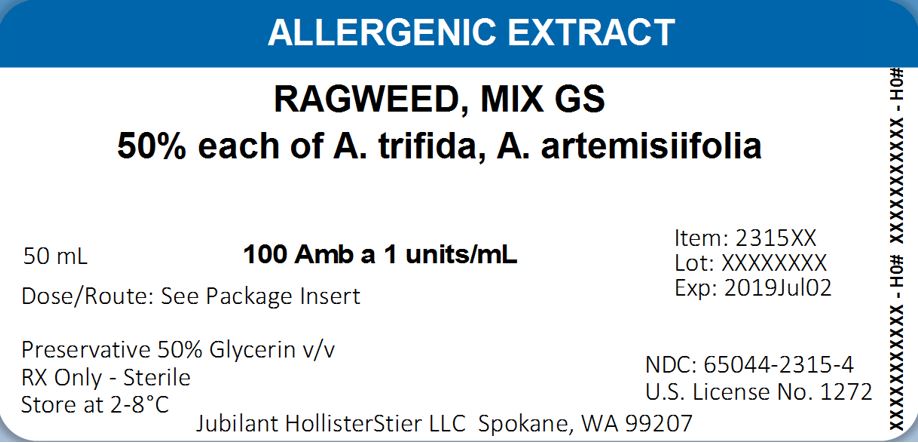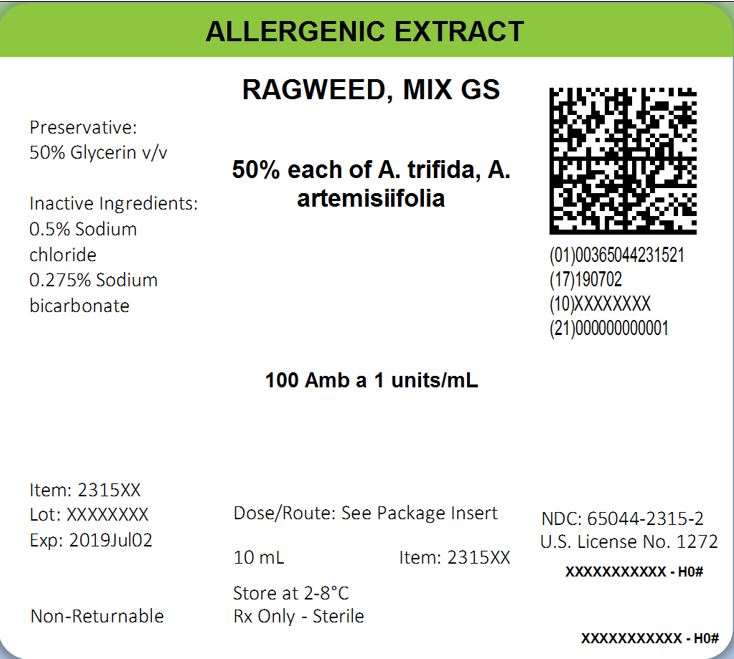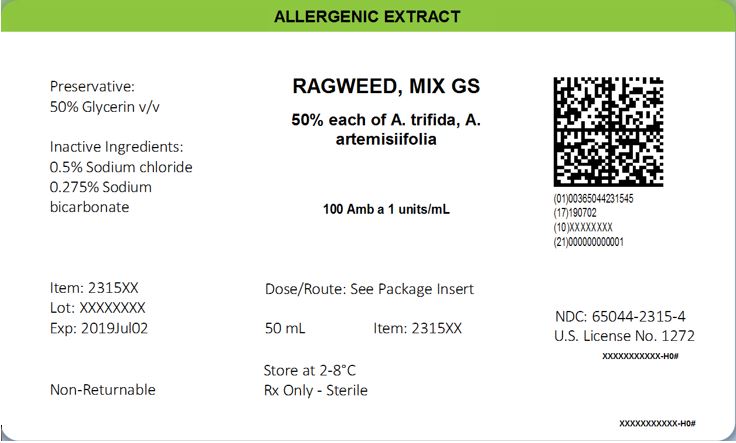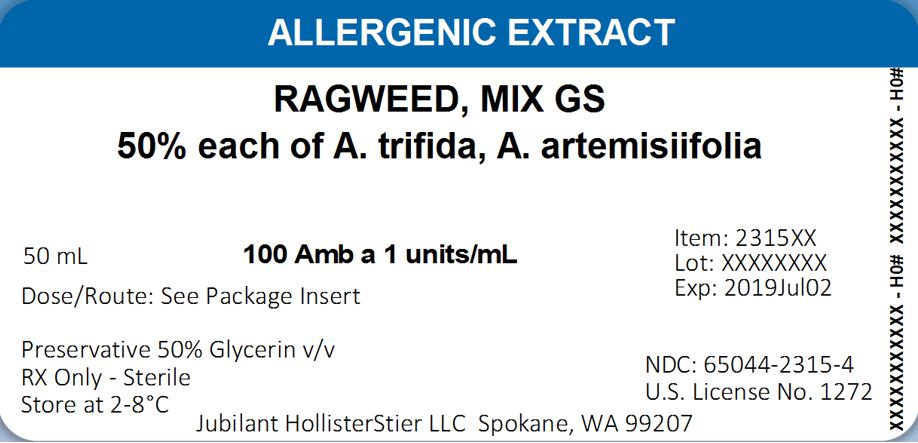Label: POLLENS - WEEDS AND GARDEN PLANTS, SHORT RAGWEED, AMBROSIA ARTEMISIIFOLIA- short ragweed, ambrosia artemisiifolia injection, solution
POLLENS - WEEDS AND GARDEN PLANTS, RAGWEED, MIXED AMBROSIA- ragweed, mixed ambrosia injection, solution
-
NDC Code(s):
65044-2297-1,
65044-2297-2,
65044-2297-4,
65044-2298-5, view more65044-2315-1, 65044-2315-2, 65044-2315-4, 65044-2316-5, 65044-2317-2, 65044-2317-3, 65044-2317-4
- Packager: Jubilant HollisterStier LLC
- Category: STANDARDIZED ALLERGENIC
- DEA Schedule: None
- Marketing Status: Biologic Licensing Application
Drug Label Information
Updated November 1, 2023
If you are a consumer or patient please visit this version.
- Download DRUG LABEL INFO: PDF XML
- Official Label (Printer Friendly)
-
HIGHLIGHTS OF PRESCRIBING INFORMATION
These highlights do not include all the information needed to use SHORT RAGWEED POLLEN ALLERGENIC EXTRACT AND SHORT AND GIANT RAGWEED POLLEN MIX ALLERGENIC EXTRACT safely and effectively. See full prescribing information for SHORT RAGWEED POLLEN ALLERGENIC EXTRACT AND SHORT AND GIANT RAGWEED POLLEN MIX ALLERGENIC EXTRACT.
SHORT RAGWEED POLLEN ALLERGENIC EXTRACT AND SHORT AND GIANT RAGWEED POLLEN MIX ALLERGENIC EXTRACT
Solution for percutaneous, intradermal, or subcutaneous administrationInitial U.S. Approval: 1925WARNING: ANAPHYLAXIS
See full prescribing information for complete boxed warning.
- Short Ragweed Pollen Allergenic Extract and Short and Giant Ragweed Pollen Mix Allergenic Extract can cause anaphylaxis, including anaphylactic shock and death (5.1)
- Do not administer to individuals with:
- severe, unstable or uncontrolled asthma;
- history of severe systemic reaction to the allergen extract when administered for diagnosis or treatment;
- medical condition that reduces the ability to survive anaphylaxis. (4)
- Observe individuals for at least 30 minutes following administration. Emergency measures and personnel trained in their use must be available in the event of a life-threatening reaction. (5.1)
- Individuals with extreme sensitivity to these products, on an accelerated immunotherapy build-up, switching to another lot, receiving high doses of these products, or exposed to similar allergens may be at increased risk of anaphylaxis. (5.1)
- These products may not be suitable for individuals who may be unresponsive to epinephrine or inhaled bronchodilators, such as those taking beta-blockers. (5.1)
INDICATIONS AND USAGE
Short Ragweed Pollen Allergenic Extract and Short and Giant Ragweed Pollen Mix Allergenic Extract are indicated for:
- Skin test diagnosis of patients with a clinical history of allergy to ragweed pollen (Short Ragweed or Short and Giant Ragweed pollen). (1)
- Immunotherapy for the reduction of ragweed pollen-induced allergic symptoms confirmed by positive skin test or by in vitro testing for pollen-specific IgE antibodies for Short and/or Giant Ragweed Pollen. (1)
DOSAGE AND ADMINISTRATION
For percutaneous, intradermal, or subcutaneous use only.
Administration:
- Percutaneous for diagnostic testing.
- Intradermal for diagnostic testing.
- Subcutaneous for immunotherapy.
See full prescribing information for details on dosing and dilution preparation. (2)
DOSAGE FORMS AND STRENGTHS
Short Ragweed Pollen Allergenic Extract solution and Short and Giant Ragweed Pollen Mix Allergenic Extract solution: stock concentrate, labeled as Amb a 1 Units/mL, in a glycerin-preserved extracting fluid, supplied in 5 mL dropper vial, and 10 and 50 mL multidose vials. (3, 16)
Refer to the vial label for the product concentration. (11)
CONTRAINDICATIONS
WARNINGS AND PRECAUTIONS
The risk of anaphylaxis may be increased in the following situations:
- Extreme sensitivity to Short Ragweed Pollen and Short and Giant Ragweed Pollen Mix allergenic extracts.
- Concomitant environmental exposure to similar allergens.
- Receipt of high concentrations and volumes of Short Ragweed Pollen and Short and Giant Ragweed Pollen Mix allergenic extracts.
- Receipt of an accelerated build-up schedule (e.g., "rush" immunotherapy).
- Changing to another lot of allergen. (5)
ADVERSE REACTIONS
Common adverse reactions reported for Short Ragweed Pollen Allergenic Extract and Short and Giant Ragweed Pollen Mix Allergenic Extract are:
- Local adverse reactions, occurring in 26 to 82% of all patients who receive subcutaneous immunotherapy (e.g., erythema, swelling, pruritus, tenderness and pain at the injection site). (6)
- Systemic adverse reactions occurring in ≤ 7% of patients who receive subcutaneous immunotherapy (e.g., generalized skin erythema, urticaria, pruritus, angioedema, rhinitis, wheezing, laryngeal edema,hypotension, and shock).Systemic reactions may be fatal. (6)
To report SUSPECTED ADVERSE REACTIONS, contact Jubilant HollisterStier at 1-800-495-7437 or Adverse.Reactions@jubl.com; or the FDA at 1-800-FDA-1088 or www.fda.gov/medwatch
DRUG INTERACTIONS
Certain medications may decrease skin test wheal and erythema responses, including antihistamines, topical corticosteroids, topical anesthetics, and tricyclic antidepressants. (7)
See 17 for PATIENT COUNSELING INFORMATION.
Revised: 11/2023
-
Table of Contents
FULL PRESCRIBING INFORMATION: CONTENTS*
WARNING: ANAPHYLAXIS
1 INDICATIONS AND USAGE
2 DOSAGE AND ADMINISTRATION
2.1 Preparation for Administration
2.2 Diagnostic Testing
2.3 Immunotherapy
3 DOSAGE FORMS AND STRENGTHS
4 CONTRAINDICATIONS
5 WARNINGS AND PRECAUTIONS
5.1 Anaphylaxis
5.2 Cross-reactions and Dose Sensitivity
6 ADVERSE REACTIONS
7 DRUG INTERACTIONS
7.1 Antihistamines
7.2 Topical Corticosteroids and Topical Anesthetics
7.3 Tricyclic Antidepressants
8 USE IN SPECIFIC POPULATIONS
8.1 Pregnancy
8.2 Lactation
8.4 Pediatric Use
8.5 Geriatric Use
11 DESCRIPTION
12 CLINICAL PHARMACOLOGY
12.1 Mechanism of Action
14 CLINICAL STUDIES
15 REFERENCES
16 HOW SUPPLIED/STORAGE AND HANDLING
16.1 How Supplied
16.2 Storage and Handling
17 PATIENT COUNSELING INFORMATION
- *
- Sections or subsections omitted from the full prescribing information are not listed.
-
BOXED WARNING
(What is this?)
WARNING: ANAPHYLAXIS
- Short Ragweed Pollen or Short and Giant Ragweed Pollen Mix allergenic extracts can cause anaphylaxis, including anaphylactic shock and death. (5.1)
- Do not administer to individuals with:
- severe, unstable or uncontrolled asthma;
- history of severe systemic reaction to the allergen extract when administered for diagnosis or treatment;
- medical condition that reduces the ability to survive anaphylaxis. (4)
- Observe individuals for at least 30 minutes following administration.Emergency measures and personnel trained in their use must be available in the event of a life-threatening reaction. (5.1)
- Individuals with extreme sensitivity to these products, on an accelerated immunotherapy build-up, switching to another lot, receiving high doses of these products, or exposed to similar allergens may be at increased risk of anaphylaxis. (5.1)
- These products may not be suitable for individuals who may be unresponsive to epinephrine or inhaled bronchodilators, such as those taking beta-blockers. (5.1)
-
1 INDICATIONS AND USAGE
SHORT RAGWEED POLLEN ALLERGENIC EXTRACT and SHORT AND GIANT RAGWEED POLLEN MIX ALLERGENIC EXTRACT are indicated for:
- Skin test diagnosis of patients with a clinical history of allergy to ragweed pollen (Short Ragweed or Short and Giant Ragweed Pollen).
- Immunotherapy for the reduction of ragweed pollen-induced allergic symptoms confirmed by positive skin test or by in vitro testing for pollen-specific IgE antibodies for Short and/or Giant Ragweed pollen.
-
2 DOSAGE AND ADMINISTRATION
For percutaneous, intradermal, or subcutaneous administration only. Do not inject intravenously.
2.1 Preparation for Administration
Appearance is clear to slightly opalescent. Parenteral drug products should be inspected visually for particulate matter and discoloration prior to administration, whenever solution and container permit. Discard solution if either of these conditions exist.
Short Ragweed Pollen and Short and Giant Ragweed Pollen Mix allergenic extracts diluted with Albumin Saline with Phenol (0.4%) (stabilized diluent) may be more potent than extracts diluted with diluents that do not contain albumin. When switching from non-stabilized to stabilized diluent, consider less concentrated initial dilutions for both intradermal testing and immunotherapy.
Different formulations, preparations, or new lots of Short Ragweed Pollen and Short and Giant Ragweed Pollen Mix allergenic extracts are not interchangeable. Dosing should be adjusted appropriately when formulations, preparations, or lots of Short Ragweed Pollen and Short and Giant Ragweed Pollen Mix allergenic extracts are changed [see Immunotherapy (2.3) and Dosage Forms and Strengths (3)].
Allergenic extracts may be prepared for intradermal (diagnosis) or subcutaneous (immunotherapy) administration by diluting stock concentrates.
- For diluent, use sterile albumin saline with phenol or sterile normal saline with phenol.
- Dilute stock concentrates by a minimum of 100-fold for intradermal testing. Dilutions of 1,000-fold or greater are appropriate starting points for patients with a clinical history of adverse reaction.
To prepare dilutions for intradermal testing and immunotherapy, start with a stock concentrate, and prepare a ten-fold (1:10) dilution by adding 0.5 mL of concentrate to 4.5 mL of sterile aqueous diluent. Prepare subsequent dilutions in a similar manner. (see Table 1)
Table 1: 10-fold Dilution Series
Dilution
Extract
Milliliters of Diluent
Dilution Strength
Amb a 1 Units/mL
Short Ragweed Pollen
Short and Giant Ragweed Pollen Mix
0
Concentrate
200
100
1
0.5 mL Concentrate
4.5
20
10
2
0.5 mL Dilution 1
4.5
2
1
3
0.5 mL Dilution 2
4.5
0.2
0.1
4
0.5 mL Dilution 3
4.5
0.02
0.01
5
0.5 mL Dilution 4
4.5
0.002
0.001
6
0.5 mL Dilution 5
4.5
0.0002
0.0001
Note: A lower starting dose and/or less concentrated dilutions may be necessary for highly sensitive patients with a clinical history of sensitivity, or for those who display severe symptoms. [see Diagnostic Testing (2.2),Percutaneous Skin Testing (2.2.1) and Intradermal (Intracutaneous) Skin Test (2.2.2)].
2.2 Diagnostic Testing
Testing is performed to identify patients that exhibit an allergic response at the site of administration. False positive reactions may occur. A positive skin test reaction must be interpreted in the context of the individual’s clinical history and known exposure to the allergen.
- Administer percutaneous tests prior to administration of intradermal tests to identify highly sensitive patients.
- Do not use allergen mixes for diagnostic testing because a positive reaction would not permit specific identification of the allergen(s) that elicited the reaction. In addition, a negative reaction would fail to indicate whether an individual component allergen would have elicited a positive reaction at full strength.
2.2.1 Percutaneous Skin Testing
Dose
Unless an individual is suspected to be at greater risk for anaphylaxis, the initial starting dose is 1 drop (approximately 0.05 mL) of undiluted allergenic extract. For individuals suspected to be at greater risk for anaphylaxis (for example, as indicated by a history of allergen-induced anaphylaxis), initiate percutaneous testing with a sequence of serial 10-fold dilutions of undiluted allergenic extract spaced 15-20 minutes apart [see Preparation for Administration (2.1)].
Administration
- Percutaneous Test: Place one drop (approximately 0.05 mL) of allergen on the skin and pierce through drop superficially into the skin, lifting slightly. Use a skin test device, such as a sterile needle, lancet, or bifurcated needle.
- Percutaneous Test using self-loading devices: Refer to the manufacturer’s product instructions.
Concurrently, use a positive histamine skin test control to identify patients whose recent use of drugs with antihistamine activity may result in a false negative skin test. Apply a 50% glycerin solution as a negative control to identify false positive responses to the extracting fluid used in the manufacture of allergenic extracts, or due to dermographism [see Drug Interactions (7)].
Interpreting Results
For interpretation of percutaneous skin tests, refer to the information provided in Allergy Diagnostic Testing: An Updated Practice Parameter.1 In addition, follow the directions provided with the percutaneous skin test devices. Measure wheal responses for the histamine positive control test at 15 minutes and for allergen tests at 15 to 20 minutes.
- The negative control (50% glycerin solution) response should measure <3-mm wheal and ≤10 mm flare (erythema).
- Response to the positive control should be at least 3 millimeters larger than the response to the negative control.
- If either the response to the histamine positive control or to the negative control do not meet the criteria above for acceptable wheal size, the results for the allergenic extracts tested at the same time should be considered invalid.
Criteria for interpretation of positive and negative results of percutaneous allergen tests (wheal diameter) are specific to the percutaneous device used to administer percutaneous tests (Reference 1, Table 2, Page S16).
2.2.2 Intradermal (Intracutaneous) Skin Test
Always perform percutaneous skin tests prior to intradermal skin tests.1, 2
Dose
Perform intradermal tests with at least 100-fold less concentrated solutions than the stock concentrates used in percutaneous tests [see Preparation and Administration (2.1)].
Use intradermal tests following a negative or equivocal percutaneous test when the patient continues to report a history of symptoms following exposure to Short and/or Giant Ragweed allergen.
Administration
Intradermally inject 0.02 mL of the allergen using a 1 mL intradermal testing syringe with a 26 or 27 gauge, 1/2" or 3/8" needle with intradermal bevel, graduated in 0.01 units. Insert needle at a 30˚ angle, bevel down.
Test concurrently with a positive histamine control at intradermal strength (0.1 mg/mL of histamine base) and an aqueous buffer negative control (Sterile Albumin Saline with Phenol, Sterile Buffered Saline with Phenol).
Interpreting Results
For interpretation of intradermal skin tests, refer to the information provided in Allergy Diagnostic Testing: An Updated Practice Parameter.1
- Measure wheal responses for the histamine positive control test and allergen tests at 10-15 minutes after injection Response to the positive control should be at least 3 millimeters greater than the response to the negative control.
- The negative control (50% glycerin solution) response should measure <3-mm wheal and ≤10 mm flare (erythema).
- If either the response to the histamine positive control or to the negative control do not meet the criteria above for acceptable wheal size, the results for the allergenic extracts tested at the same time should be considered invalid.
2.3 Immunotherapy
For subcutaneous administration only.
Administration of Immunotherapy
Administer immunotherapy by subcutaneous injection in the lateral aspect of the arm or thigh. Avoid injection directly into any blood vessels. Administer injections with a sterile 1 mL allergy treatment syringe with a 26 or 27 gauge, 1/2", beveled needle, graduated in 0.01 units.
The optimal interval between doses of allergenic extract varies among individuals. Injections are usually given one or two times per week until the maintenance dose is reached, at which time the injection interval is increased to 2, 3, and finally 4 weeks.
Most adverse reactions occur within 30 minutes after injection. Therefore, observe patients for at least 30 minutes. For high risk patients, 30 minutes of observation may not be sufficient.2
Dosing of Short Ragweed Pollen and Short and Giant Ragweed Pollen Mix allergenic extracts for allergen immunotherapy is highly individualized. Adjust dose according to the degree of sensitivity of the patient, tolerance to the extract administered during the early phases of an injection regimen, and the clinical response. Dosing is individualized by choice of an initial dose, the schedule of dose build-up, the target maintenance dose, the actual maintenance dose, and the duration of treatment.
The large volume of solution for immunotherapy may produce increased discomfort in the pediatric population. In order to achieve the total dose required, the volume of the dose may need to be divided into more than one injection per visit.²
2.3.1 Dose Build-up
Following the first administration of 0.03 mL of the selected initial dilution of allergenic extract , dosing is increased in 0.03 mL to 0.12 mL increments until 0.3 mL is reached, following which 0.03 mL is administered from the next most concentrated allergen extract or allergen mixture vial in the dilution series. The interval between doses is usually 3 to 7 days during dose build-up. Proceed in this manner until a maintenance dose is reached. The final maintenance dose may not be the target maintenance dose selected at the beginning of therapy.
The following adjustments may be necessary during dose build-up:
- If allergic symptoms or local reactions develop shortly after dose administration, decrease the dose volume to one-half or one-quarter of the maximum dose previously attained.
- If the patient is experiencing any seasonal allergy symptoms, decrease the dose volume to one-half or one‑quarter of the maximum dose previously attained.
- Adjust the dose periodically based on the patient’s tolerance and reaction.
- Decrease the dose if the previous injection resulted in a marked local reaction.
- Repeat the previous dose or reduce the dose at the next administration if local reactions persist for longer than 24 hours.
- Decrease the dose if the previous injection resulted in a systemic reaction.Any evidence of a systemic reaction is an indication for a significant (at least 75%) reduction in the subsequent dose or the cessation of immunotherapy.
- Repeated systemic reactions, however mild, are sufficient reason for the cessation of further attempts to increase the reaction-causing dose.
2.3.2 Maintenance Dose Selection, Adjustments, and Intervals
The maintenance dose is the dose that provides therapeutic efficacy without severe adverse local or systemic reactions. This dose may be limited by adverse reactions and may not be the original targeted maintenance dose. Select a maintenance dose based on the patient's clinical response and tolerance.
- Suggested maintenance dose is 0.3 mL of the undiluted allergen extract. Occasionally, higher doses are necessary to relieve symptoms.
- Maintenance doses larger than 0.3 mL of undiluted allergen extract may cause patient discomfort due to the 50% glycerin content.
- After the maintenance dose is achieved, increase the injection interval to 2 weeks, then 3 weeks, and finally 4 weeks, as tolerated. Administer the maintenance dose at a given interval three or four times before further increasing the interval to assure that no reactions occur. Protection may be lost rapidly if the interval between doses is more than 4 weeks.
The following adjustments to the maintenance dose may be necessary:
-
Withhold immunotherapy and/or reduce dosage, if any of the following conditions exist:
- Severe symptoms of rhinitis and/or asthma. Decrease dose to one-half or one-quarter of the maximum dose previously attained if the patient has any seasonal symptoms.
- Allergic symptoms or a local reaction following the prior dose.
- Infection accompanied by fever.
- Exposure to excessive amounts of clinically relevant allergen prior to a scheduled injection.
In situations prompting dose reduction, a cautious increase in dosage can be attempted once the reduced dose is tolerated.
Decrease the interval between doses if symptoms develop before the next injection is scheduled.
In some patients, the dosage may be increased and/or the dosing interval shortened based on individual responses and dosing requirements. If the onset of symptoms is soon after the initiation of immunotherapy, decrease the interval between each dose.
Changing to a different lot of extract: All extracts can lose allergenic activity over time and extracts vary in allergenic activity. Two different lots of extract could differ substantially in allergenic activity, even if they are the same formula and concentration. The volume of the first dose from the new vial should not exceed 50% of the previous dose. Do not use extracts beyond their expiry date.
Changing to a different formulation of extract or to an extract from a different manufacturer: Decrease the starting dose of the new extract when the extract is the same formula and dilution as the one previously used. In general, a volume dose reduction to 50% of the previous product dose is adequate, but each situation must be evaluated separately considering the patient's history of sensitivity, tolerance of previous injections, and other factors. If the patient tolerates the 50% decrease, then raise the next dose to the previous tolerated dose amount. To re-establish the maintenance dose the starting interval between doses should not be greater than one week.
Prolonged period has elapsed since the last injection: Patients may lose tolerance for allergen injections during prolonged intervals (> 4 weeks) between doses. The duration of tolerance is an individual characteristic and varies from patient to patient. In general, the longer the lapse in the injection schedule, the greater dose reduction required.
Changes made in the extract concentrate formula: Changes other than those listed above such as a difference in extracting fluid (e.g., change from non-glycerin extracts to 50% glycerin extracts), combining two or more stock concentrates, or any other change can affect a patient’s tolerance of the treatment. Extra dilutions are recommended whenever starting a revised formula. The greater the change, the greater the number of dilutions required.
Duration of Treatment
The duration of treatment for immunotherapy has not been established. A period of two to three years of injection therapy constitutes an average minimum course of treatment. Evaluate patients for treatment response at least every 6 to 12 months while they receive immunotherapy.
-
3 DOSAGE FORMS AND STRENGTHS
Short Ragweed Pollen Allergenic Extract and Short and Giant Ragweed Pollen Mix Allergenic Extracts solution: stock concentrate, labeled in Amb a 1 Units/mL, in a glycerin-preserved extracting fluid, supplied in 5 mL dropper vial, and 10 and 50 mL multidose vials. (3, 16)
Refer to the vial label for the product concentration. (11)
-
4 CONTRAINDICATIONS
Short Ragweed Pollen and Short and Giant Ragweed Pollen Mix Allergenic Extracts are contraindicated in individuals with the following conditions:
- Severe, unstable or uncontrolled asthma.
- History of any severe systemic reaction to the allergen extract when administered for diagnosis or treatment.
- Medical condition that reduces the ability to survive anaphylaxis.
-
5 WARNINGS AND PRECAUTIONS
5.1 Anaphylaxis
Anaphylaxis, which may lead to death, can occur in individuals following the administration of Short Ragweed Pollen and Short and Giant Ragweed Pollen Mix allergenic extracts, particularly in the following situations:
- Extreme sensitivity to Short Ragweed Pollen and Short and Giant Ragweed Pollen Mix allergenic extracts.
- Concomitant environmental exposure to allergens.
- Receipt of high doses of the Short Ragweed Pollen and Short and Giant Ragweed Pollen Mix allergenic extracts.
- Receipt of an accelerated build-up schedule (“rush” immunotherapy)
- Change from one lot of a particular Short Ragweed Pollen or Short and Giant Ragweed Pollen Mix allergenic extract to another lot of the same Short Ragweed Pollen or Short and Giant Ragweed Pollen Mix allergenic extract.
Administer Short Ragweed Pollen and Short and Giant Ragweed Pollen Mix allergenic extracts in a healthcare setting under the supervision of a physician prepared to manage anaphylaxis; management may include use of inhaled bronchodilators and use of epinephrine. Short Ragweed Pollen and Short and Giant Ragweed Pollen Mix allergenic extracts may not be suitable for individuals who may be unresponsive to epinephrine or inhaled bronchodilators, such as those taking beta-blockers. See prescribing information for epinephrine for complete information, particularly on medications that blunt or potentiate epinephrine activity. Individuals should remain in the physician’s office for a minimum of 30 minutes after receiving an injection of allergenic extracts, so that any adverse reaction can be observed and properly handled.
5.2 Cross-reactions and Dose Sensitivity
When determining the final dose of an allergen mixture for immunotherapy, consider cross-reactivity among component extracts.
Determine the initial dilution of allergenic extract, starting dose, and progression of dosage based on the patient’s history and results of skin tests [see Dosage and Administration (2)]. Strongly positive skin tests can be indicators for potential adverse reactions.
-
6 ADVERSE REACTIONS
Common adverse reactions reported for Short Ragweed Pollen Allergenic Extract and Short and Giant Ragweed Pollen Mix Allergenic Extract are:
- Local reactions occurring in 26 to 82% of all patients who receive subcutaneous immunotherapy, at the injection site (e.g., erythema, swelling, pruritus, tenderness and pain).
- Systemic adverse reactions occurring in ≤ 7% of patients who receive subcutaneous immunotherapy (e.g., generalized skin erythema, urticaria, pruritus, angioedema, rhinitis, wheezing, laryngeal edema, hypotension, and shock).Systemic reactions may be fatal.2
No clinical trials of Short Ragweed Pollen Allergenic Extract and Short and Giant Ragweed Pollen Mix Allergenic Extract have been conducted.
Published studies of allergenic extracts report systemic reactions occurring in fewer than 1% in patients receiving conventional immunotherapy and greater than 36% in patients receiving rush immunotherapy. Most systemic reactions occurred within 30 minutes of injection. However, systemic reactions have been reported to occur up to 2 hours after the final injection with rush schedules. Some reactions have occurred up to 6 hours after skin tests or immunotherapy.2, 3
-
7 DRUG INTERACTIONS
7.1 Antihistamines
Do not perform skin testing with Short Ragweed Pollen and Short and Giant Ragweed Pollen Mix allergenic extracts within 3 to 10 days of first-generation H1-histamine receptor blockers (e.g., clemastine, diphenhydramine) and second-generation antihistamines (e.g., loratadine, fexofenadine) being used. These products suppress histamine skin test reactions and could mask a positive response.1, 2
7.2 Topical Corticosteroids and Topical Anesthetics
Topical corticosteroids may suppress skin reactivity; therefore, discontinue use at the skin test site for at least 2 to 3 weeks before skin testing. Avoid use of topical local anesthetics at skin test sites because they can suppress flare responses.1, 2
-
8 USE IN SPECIFIC POPULATIONS
8.1 Pregnancy
Risk Summary
All pregnancies have a risk of birth defect, loss, or other adverse outcomes. In the U.S. general population, the estimated background risk of major birth defects and miscarriage in clinically recognized pregnancies is 2 to 4% and 15 to 20%, respectively. There are no human or animal data to establish the presence or absence of Short Ragweed Pollen Allergenic Extract and Short and Giant Ragweed Pollen Mix Allergenic Extract-associated risks during pregnancy.
8.2 Lactation
Risk Summary
It is not known whether Short Ragweed Pollen Allergenic Extract and Short and Giant Ragweed Pollen Mix Allergenic Extract are present in human milk. Data are not available to assess the effects of these extracts on the breastfed child or on milk production/excretion. The developmental and health benefits of breastfeeding should be considered along with the mother’s clinical need for allergenic extracts and any potential adverse effects on the breastfed child from the extracts or from the underlying maternal condition.
8.4 Pediatric Use
For use of these products in children younger than 5 years of age, consideration should be given to the patient’s ability to comply and cooperate with receipt of the product and the potential for difficulty in communicating with the child regarding systemic reactions.²
The volume of a dose for immunotherapy may need to be divided for pediatric patients [see Dosage and Administration (2.3)].
-
11 DESCRIPTION
The expression of concentration applied to Short Ragweed Pollen Allergenic Extract and Short and Giant Ragweed Pollen Mix Allergenic Extract is Amb a 1 Units/mL. Amb a 1 is considered the most important allergen in Short Ragweed and is the basis for standardization. Short Ragweed Pollen Allergenic Extract and Short and Giant Ragweed Pollen Mix Allergenic Extracts are standardized by comparison to reference standards supplied by the Center for Biologics Evaluation and Research (CBER) of the FDA.
Short Ragweed Pollen and Short and Giant Ragweed Pollen Mix allergenic extracts are supplied in a Glycero Cocas extraction solution, which consists of 0.5% sodium chloride for isotonicity, 0.275% sodium bicarbonate as buffer, and 50% glycerin (volume/volume) as preservative.
-
12 CLINICAL PHARMACOLOGY
12.1 Mechanism of Action
The skin test reaction results from interaction of the introduced allergen and allergen-specific IgE antibodies bound to mast cells, leading to mast cell degranulation and release of histamine, tryptase and other mediators, which results in the formation of the wheal and flare.
The precise mechanisms of action of allergen immunotherapy are not known. Immunologic responses to immunotherapy include changes in allergen-specific IgE levels, allergen-specific IgG levels, and regulatory T cell responses.
- 14 CLINICAL STUDIES
-
15 REFERENCES
1. Bernstein IL, Li JT, Bernstein Dl, et al. Allergy diagnostic testing: an updated practice parameter. Ann Allergy Asthma Immunol. 2008 Mar;100: S1-148.
2. Cox L, Nelson H, Lockey R, Calabria C, Chacko T, Finegold I, et al. Allergen immunotherapy: A practice parameter third update. J Allergy Clin Immunol. 2011 Jan;127: S1-55.
3. Greineder DK. Risk management in allergen immunotherapy. J Allergy Clin Immunol. 1996 Dec;98(6 Pt 3):S330‑4.
4. Norman PS, Winkenwerder WL, Lichtenstein LM. Immunotherapy of hay fever with ragweed antigen E: comparisons with whole pollen extract and placebos. J Allergy. 1968; 42(2):93-108.
5. Reisman RE, Wicher K, Arbesman CE. Immunotherapy with antigen E. J Allergy. 1969 Aug;44(2):82-95.
-
16 HOW SUPPLIED/STORAGE AND HANDLING
16.1 How Supplied
Short Ragweed Pollen Allergenic Extract and Short and Giant Ragweed Pollen Mix Allergenic Extract are supplied as 50% glycerin stock concentrates labeled in Amb a 1 units/mL and provided in 10 milliliter and 50 milliliter vials for use in percutaneous skin testing, intradermal skin testing, and subcutaneous immunotherapy. These extracts may also be supplied in 5 milliliter dropper vials for percutaneous testing only.
These products are supplied as listed in Table 2.
Table 2: Available Products
SHORT RAGWEED POLLEN ALLERGENIC EXTRACT
NDC
Strength/Container
65044-2297-1
200 Amb a 1 Units/mL, 5 mL dropper vial for percutaneous testing
65044-2297-2
200 Amb a 1 Units/mL, 10 mL multi-dose vial
65044-2297-4
200 Amb a 1 Units/mL, 50 mL multi-dose vial
SHORT AND GIANT RAGWEED POLLEN ALLERGENIC EXTRACT
NDC
Strength/Container
65044-2315-1
100 Amb a 1 Units/mL, 5 mL dropper vial for percutaneous testing
65044-2315-2
100 Amb a 1 Units/mL, 10 mL multi-dose vial
65044-2315-4
100 Amb a 1 Units/mL, 50 mL multi-dose vial
-
17 PATIENT COUNSELING INFORMATION
Instruct patients to remain in the office under observation for a minimum of 30 minutes after an injection or longer, if deemed necessary for the individual.
Inform patients that reactions may occur more than 30 minutes after skin testing or an injection.
Instruct patient to recognize the following symptoms as systemic adverse reactions and seek emergency medical care right away if any of these symptoms occur:
- Unusual swelling and/or tenderness at the injection site
- Hives or itching of the skin
- Swelling of face and/or mouth
- Sneezing, coughing, or wheezing
- Shortness of breath
- Nausea
- Dizziness or faintness
Manufacturer:
Jubilant HollisterStier LLC
Spokane, WA 99207 U.S.A.
U.S. License No. 1272
- PRINCIPAL DISPLAY PANEL
- PRINCIPAL DISPLAY PANEL
- PRINCIPAL DISPLAY PANEL
- PRINCIPAL DISPLAY PANEL
- PRINCIPAL DISPLAY PANEL
- PRINCIPAL DISPLAY PANEL
-
INGREDIENTS AND APPEARANCE
POLLENS - WEEDS AND GARDEN PLANTS, SHORT RAGWEED, AMBROSIA ARTEMISIIFOLIA
short ragweed, ambrosia artemisiifolia injection, solutionProduct Information Product Type STANDARDIZED ALLERGENIC Item Code (Source) NDC:65044-2297 Route of Administration PERCUTANEOUS, SUBCUTANEOUS Active Ingredient/Active Moiety Ingredient Name Basis of Strength Strength AMBROSIA ARTEMISIIFOLIA POLLEN (UNII: K20Y81ACO3) (AMBROSIA ARTEMISIIFOLIA POLLEN - UNII:K20Y81ACO3) AMBROSIA ARTEMISIIFOLIA POLLEN 0.05 g in 1 mL Inactive Ingredients Ingredient Name Strength GLYCERIN (UNII: PDC6A3C0OX) SODIUM CHLORIDE (UNII: 451W47IQ8X) SODIUM BICARBONATE (UNII: 8MDF5V39QO) Packaging # Item Code Package Description Marketing Start Date Marketing End Date 1 NDC:65044-2297-1 5 mL in 1 VIAL; Type 0: Not a Combination Product 2 NDC:65044-2297-2 10 mL in 1 VIAL; Type 0: Not a Combination Product 3 NDC:65044-2297-4 50 mL in 1 VIAL; Type 0: Not a Combination Product Marketing Information Marketing Category Application Number or Monograph Citation Marketing Start Date Marketing End Date BLA BLA103880 10/18/1977 POLLENS - WEEDS AND GARDEN PLANTS, SHORT RAGWEED, AMBROSIA ARTEMISIIFOLIA
short ragweed, ambrosia artemisiifolia injection, solutionProduct Information Product Type STANDARDIZED ALLERGENIC Item Code (Source) NDC:65044-2298 Route of Administration INTRADERMAL Active Ingredient/Active Moiety Ingredient Name Basis of Strength Strength AMBROSIA ARTEMISIIFOLIA POLLEN (UNII: K20Y81ACO3) (AMBROSIA ARTEMISIIFOLIA POLLEN - UNII:K20Y81ACO3) AMBROSIA ARTEMISIIFOLIA POLLEN 500 [PNU] in 1 mL Inactive Ingredients Ingredient Name Strength PHENOL (UNII: 339NCG44TV) SODIUM CHLORIDE (UNII: 451W47IQ8X) SODIUM BICARBONATE (UNII: 8MDF5V39QO) GLYCERIN (UNII: PDC6A3C0OX) Packaging # Item Code Package Description Marketing Start Date Marketing End Date 1 NDC:65044-2298-5 5 mL in 1 VIAL; Type 0: Not a Combination Product Marketing Information Marketing Category Application Number or Monograph Citation Marketing Start Date Marketing End Date BLA BLA103880 10/18/1977 03/01/2022 POLLENS - WEEDS AND GARDEN PLANTS, RAGWEED, MIXED AMBROSIA
ragweed, mixed ambrosia injection, solutionProduct Information Product Type STANDARDIZED ALLERGENIC Item Code (Source) NDC:65044-2315 Route of Administration PERCUTANEOUS, SUBCUTANEOUS Active Ingredient/Active Moiety Ingredient Name Basis of Strength Strength AMBROSIA TRIFIDA POLLEN (UNII: KU1V1898XX) (AMBROSIA TRIFIDA POLLEN - UNII:KU1V1898XX) AMBROSIA TRIFIDA POLLEN 0.05 g in 1 mL AMBROSIA ARTEMISIIFOLIA POLLEN (UNII: K20Y81ACO3) (AMBROSIA ARTEMISIIFOLIA POLLEN - UNII:K20Y81ACO3) AMBROSIA ARTEMISIIFOLIA POLLEN 0.05 g in 1 mL Inactive Ingredients Ingredient Name Strength GLYCERIN (UNII: PDC6A3C0OX) SODIUM CHLORIDE (UNII: 451W47IQ8X) SODIUM BICARBONATE (UNII: 8MDF5V39QO) Packaging # Item Code Package Description Marketing Start Date Marketing End Date 1 NDC:65044-2315-1 5 mL in 1 VIAL; Type 0: Not a Combination Product 2 NDC:65044-2315-2 10 mL in 1 VIAL; Type 0: Not a Combination Product 3 NDC:65044-2315-4 50 mL in 1 VIAL; Type 0: Not a Combination Product Marketing Information Marketing Category Application Number or Monograph Citation Marketing Start Date Marketing End Date BLA BLA103880 10/18/1977 POLLENS - WEEDS AND GARDEN PLANTS, RAGWEED, MIXED AMBROSIA
ragweed, mixed ambrosia injection, solutionProduct Information Product Type STANDARDIZED ALLERGENIC Item Code (Source) NDC:65044-2316 Route of Administration INTRADERMAL Active Ingredient/Active Moiety Ingredient Name Basis of Strength Strength AMBROSIA TRIFIDA POLLEN (UNII: KU1V1898XX) (AMBROSIA TRIFIDA POLLEN - UNII:KU1V1898XX) AMBROSIA TRIFIDA POLLEN 500 [PNU] in 1 mL AMBROSIA ARTEMISIIFOLIA POLLEN (UNII: K20Y81ACO3) (AMBROSIA ARTEMISIIFOLIA POLLEN - UNII:K20Y81ACO3) AMBROSIA ARTEMISIIFOLIA POLLEN 500 [PNU] in 1 mL Inactive Ingredients Ingredient Name Strength PHENOL (UNII: 339NCG44TV) SODIUM CHLORIDE (UNII: 451W47IQ8X) SODIUM BICARBONATE (UNII: 8MDF5V39QO) GLYCERIN (UNII: PDC6A3C0OX) Packaging # Item Code Package Description Marketing Start Date Marketing End Date 1 NDC:65044-2316-5 5 mL in 1 VIAL; Type 0: Not a Combination Product Marketing Information Marketing Category Application Number or Monograph Citation Marketing Start Date Marketing End Date BLA BLA103880 10/18/1977 03/01/2022 POLLENS - WEEDS AND GARDEN PLANTS, RAGWEED, MIXED AMBROSIA
ragweed, mixed ambrosia injection, solutionProduct Information Product Type STANDARDIZED ALLERGENIC Item Code (Source) NDC:65044-2317 Route of Administration PERCUTANEOUS, SUBCUTANEOUS Active Ingredient/Active Moiety Ingredient Name Basis of Strength Strength AMBROSIA TRIFIDA POLLEN (UNII: KU1V1898XX) (AMBROSIA TRIFIDA POLLEN - UNII:KU1V1898XX) AMBROSIA TRIFIDA POLLEN 20000 [PNU] in 1 mL AMBROSIA ARTEMISIIFOLIA POLLEN (UNII: K20Y81ACO3) (AMBROSIA ARTEMISIIFOLIA POLLEN - UNII:K20Y81ACO3) AMBROSIA ARTEMISIIFOLIA POLLEN 20000 [PNU] in 1 mL Inactive Ingredients Ingredient Name Strength GLYCERIN (UNII: PDC6A3C0OX) SODIUM CHLORIDE (UNII: 451W47IQ8X) SODIUM BICARBONATE (UNII: 8MDF5V39QO) Packaging # Item Code Package Description Marketing Start Date Marketing End Date 1 NDC:65044-2317-2 10 mL in 1 VIAL; Type 0: Not a Combination Product 2 NDC:65044-2317-3 30 mL in 1 VIAL; Type 0: Not a Combination Product 3 NDC:65044-2317-4 50 mL in 1 VIAL; Type 0: Not a Combination Product Marketing Information Marketing Category Application Number or Monograph Citation Marketing Start Date Marketing End Date BLA BLA103880 10/18/1977 03/01/2022 Labeler - Jubilant HollisterStier LLC (069263643) Registrant - Jubilant HollisterStier LLC (069263643)

